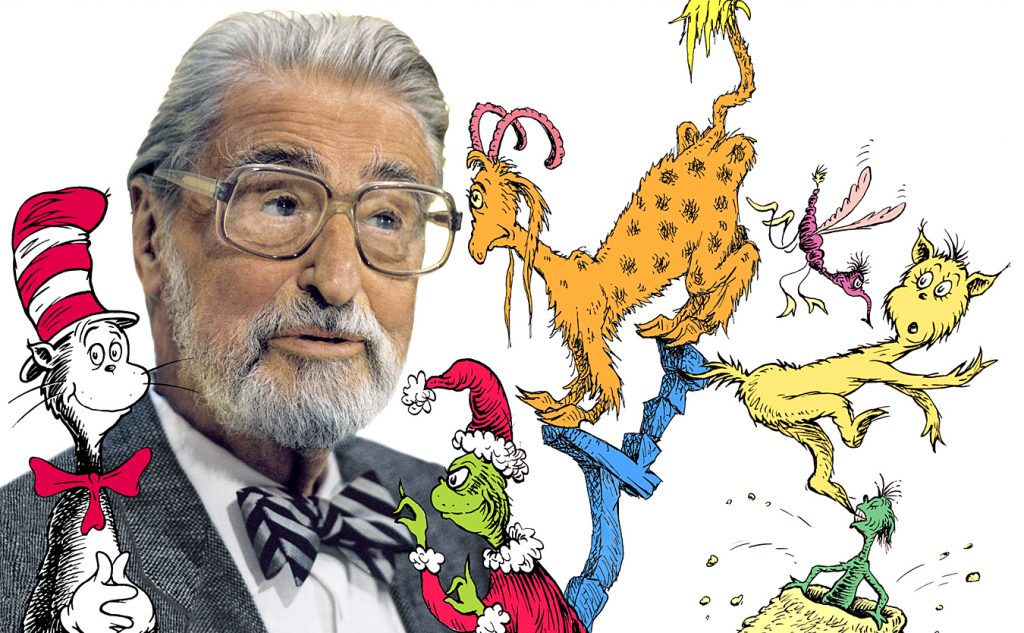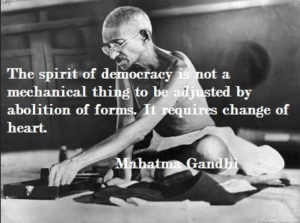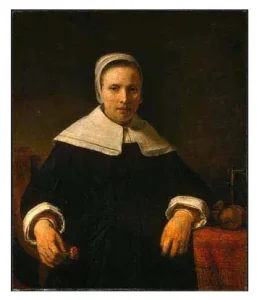Theodor Geisel, beloved children’s author, had a life before he put the hat on the cat. Born March 2, 1904, in Springfield, Massachusetts, Geisel was the only son of German-born immigrants. He spent a normal childhood with his sister and parents, before going to college to become a teacher. Geisel dropped out of college shortly before completing his doctorate in literature. He would eventually turn his almost doctorate and his mother’s maiden name into his now famous pen name, Dr. Seuss.1

In 1927, Geisel decided to turn his passion for drawing and writing into a career in advertising. One of his early successes in advertising was his drawing for Flit insecticide, whose mascot looked very similar to the cat that would eventually wear a striped hat.2 He later created an entire campaign for Essomarine Oil, a division of Standard Oil, called Seuss Navy, in which he designed certificates of membership, pamphlets, and even ashtrays and cocktail glasses that were passed out at trade shows. The Seuss Navy ads ran from 1936 to 1941, and contained many of the sea creatures that would later appear in his books.3 Geisel used many of his made up creatures in various ad campaigns and was the first person to use humor to sell products, altering the advertising industry.4

In 1941, Geisel left advertising to work as a political cartoonist for liberal New York newspaper PM. He drew over 4oo cartoons targeting such topics as isolationism, antisemitism, and racism. He routinely mocked Hitler and Mussolini, but he had a particular flair for attacking American nationalism as well. Believing that the American Nationalist Movement was just another form of fascism, Geisel made Charles Lindbergh a frequent subject of his cartoons.5 After the Japanese attack on Pearl Harbor, Geisel began to use his cartoons to support the war against Japan. He drew cartoons that “depicted Hideki Tojo, the Prime Minister and Supreme Military Leader of Japan, as an ugly stereotype, with squinting eyes and a sneering grin.”6 Geisel was in support of Japanese internment camps and drew several cartoons about them.

It can be hard to imagine that Dr. Seuss could be a racist in his depiction of Asians, but he later admitted that this was exactly the case. At the time, PM did not receive one letter of complaint about Geisel’s stereotypical depiction of Asians, although they received many letters when Geisel mocked the German dachshund, which was popular among American dog owners. Dr. Seuss later said that his 1954 book, “Horton Hears a Who,” written after a trip to Japan and dedicated to a Japanese friend, is meant to be an apology to the Japanese people for his depictions of them during World War II. In the 1980’s, Geisel looked through all his children’s books and removed anything he felt was racist, changing them for any future publication.7
Geisel’s political cartoons ended when he joined the Army in 1943. The now Captain Geisel was assigned to a unit that made training films for the Army, working with the likes of Stan Lee (creator of super heroes) and Chuck Jones (creator of the Road Runner and Wile E. Coyote).8 Geisel and Jones would become life long friends and would work together on various projects, including the animated “How the Grinch Stole Christmas,” which is still shown every year on television.

Geisel’s first children’s book was “And to Think I Saw It on Mulberry Street,” and was published in 1937. However, his writing career almost never happened. The book had been turned down by 27 publishers and Geisel was ready to give up the idea of becoming a children’s author when he ran into an old college friend while walking down the street. His friend had recently become an editor at Vanguard Press and asked Geisel to send him the book so he could show his boss. Geisel would later say in interviews that it was pure luck that he walked down that side of the street that day.9
Dr. Seuss later claimed that he did not like to write books that had a moral or ethical lesson, because children could see a lesson coming and would not want to read the book.10 However, all of Geisel’s books, except his Beginner Books, contained lessons of some sort. Dr. Seuss wrote books with lessons on environmentalism, racial equality, the pointlessness of the arms race, materialism, and respect, just to name a few. He was one of the first children’s authors to write books for children with the respect and care typically reserved for adult literature.11
Dr. Seuss died on September 24, 1991 at his home. He was asked shortly before he passed away to leave a message for children. He wrote “The best slogan I can think of to leave the kids of the U.S.A. would be ‘We can…and we’ve got to…do better than this.’ He then crossed out ‘the kids of.'”12 Dr. Seuss left a legacy of children’s literature that will not soon be forgotten, but he did more than that; Dr. Seuss taught children to think.
- Janet Schulman and Cathy Goldsmith, Your Favorite Seuss (New York: Random House, 2004), 6. ↵
- Louis Menand, “Cat People,” The New Yorker (December 2002). ↵
- Janet Schulman and Cathy Goldsmith, Your Favorite Seuss (New York: Random House, 2004), 55. ↵
- Janet Schulman and Cathy Goldsmith, Your Favorite Seuss (New York: Random House, 2004), 117. ↵
- Sophie Gilbert, “The Complicated Relevance of Dr. Seuss’s Political Cartoons,” The Atlantic (January 2017). ↵
- Sophie Gilbert, “The Complicated Relevance of Dr. Seuss’s Political Cartoons,” The Atlantic (January 2017). ↵
- Sophie Gilbert, “The Complicated Relevance of Dr. Seuss’s Political Cartoons,” The Atlantic (January 2017). ↵
- Janet Schulman and Cathy Goldsmith, Your Favorite Seuss (New York: Random House, 2004), 9. ↵
- Louis Menand, “Cat People,” The New Yorker (December 2002). ↵
- Janet Schulman and Cathy Goldsmith, Your Favorite Seuss (New York: Random House, 2004), 190. ↵
- Janet Schulman and Cathy Goldsmith, Your Favorite Seuss (New York: Random House, 2004), 84. ↵
- Janet Schulman and Cathy Goldsmith, Your Favorite Seuss (New York: Random House, 2004), 190. ↵



125 comments
Addie Piatz
Without Dr. Seuss I don’t think my childhood would have been the same. From loving his drawings to my mom reading me his books as a bedtime story I feel like i’ve grown up with him. I didn’t know he was a political cartoonist or that he used his drawings for campaigns. The message he left for his children was so moving and I completely agree with it. Im so thankful that I got to read his growing up.
Bianca-Rhae Jacquez
Every child now a days knows who Dr. Seuss is. He is a legend. He brought so much amazement to kids life. Personally Dr. Seuss is the author that made me fall in love with reading. I had no idea that his first career of choice was to become a teacher. He was an extremely lucky man to have ran into his friend of the street like that. I would hate to know what that world would be like without Dr. Seuss.
Paola Arellano
At my elementary school, we would have an entire week that celebrated Dr. Seuss and his life. He brought so much joy and beauty to my childhood and still continues to do so for many young children that read his books. I remember watching The Cat in the Hat way too many times and enjoyed it every single one of them. I had no idea that he actually went to school to be a teacher and of course it is a great career but it make sense as to why he was a children’s book writer. It is crazy to think that he is “racist” against the asians but I had heard this before and regardless of this fact, I do believe that he is an incredibly creative man.
Diamond Davidson
Dr. Sesus was my favorite as a child. I loved every book her wrote and ever movie that was brought to life as anime or real life people. I would still watch it till this day because I just love everything about him and his books, I really hope he was still I live to make more and more because I really wanted a Cat in the Hat part 2. But I’m glad he help children learn. Overall, this was a well-written and amazing article to read.
Vanessa Sanchez
Amazing job completely loved the story. Dr. Seuss one of the most well-known persons. He is being shown to you ever since you attended elementary school. Its great knowing his history where he comes from what he is and how he came to be what he is known for now. Dr. Seuss after being such a big part of our childhood and still going for children’s know a day it was pretty great and interesting knowing more about him personally and not just professionally.
Oscar Ortega
Dr Seuss is one of the most well-known names in America. Despite this, many things, even his real name, aren’t all that well known, so learning more about his life from the beginning to just before he became the man responsible for so many now famous books is nothing short of fascinating, and the stories behind both his earlier works and how he was ultimately able to get the chance to touch millions with his work, and even how he and his work evolved in his later years, is something I’m happy to learn.
Antonio Coffee
I appreciated that his article showed both sides of Dr. Seuss. It acknowledged his faults and I was shocked that he drew the Japanese with racial stereotypes. This was a side of Dr. Seuss that I was unaware of. I was gladdened to see that Dr. Seuss later realized this and went back and tried to correct everything. Dr. Seuss made the world a brighter place and left all of us with some great advice to improve the world.
Rebeca Escobar
Reading about Dr. Seuss’ racist depiction of the Japenese made me start to reconsider what I thought of him. However, I’m glad that he realized his thought process was wrong and corrected his mindset. Regardless, Seuss is an important figure and very famous amongst many young children. All his books are amazing reads regardless of age, even though they’re more aimed at younger children. I’m happy he’s a celebrated figure every year and every child gets to learn about him.
Samantha Ruvalcaba
Good article. When I first heard about Dr. Seuss’ racist remarks/cartoons, I was disappointed. However, I liked that this article remained unbiased. His racist actions were mentioned, noted as racist, and the article went on to describe his later achievements. I find it commendable that the author made sure to mention that “Seuss'” made sure to redact his problematic illustrations and words from his books before they continued to be published, and that he turned it around to create positive, lesson learning for kids. This note keeps the reader from developing blinders of seeing Suess for just his racist remarks and nothing else.
Christopher Hohman
Nice article. Dr. Seuss was quite an influential children’s story writer. My mother used to read them to my sister and I when we were younger, and we always enjoyed it when she did. I do not think that we can hold his racist cartoons against the Japanese against him though. He lived in a time when prejudices were everywhere. And he did try to make up for it later in life by dedicating a book to his Japanese friend and editing his books to make them less racist.